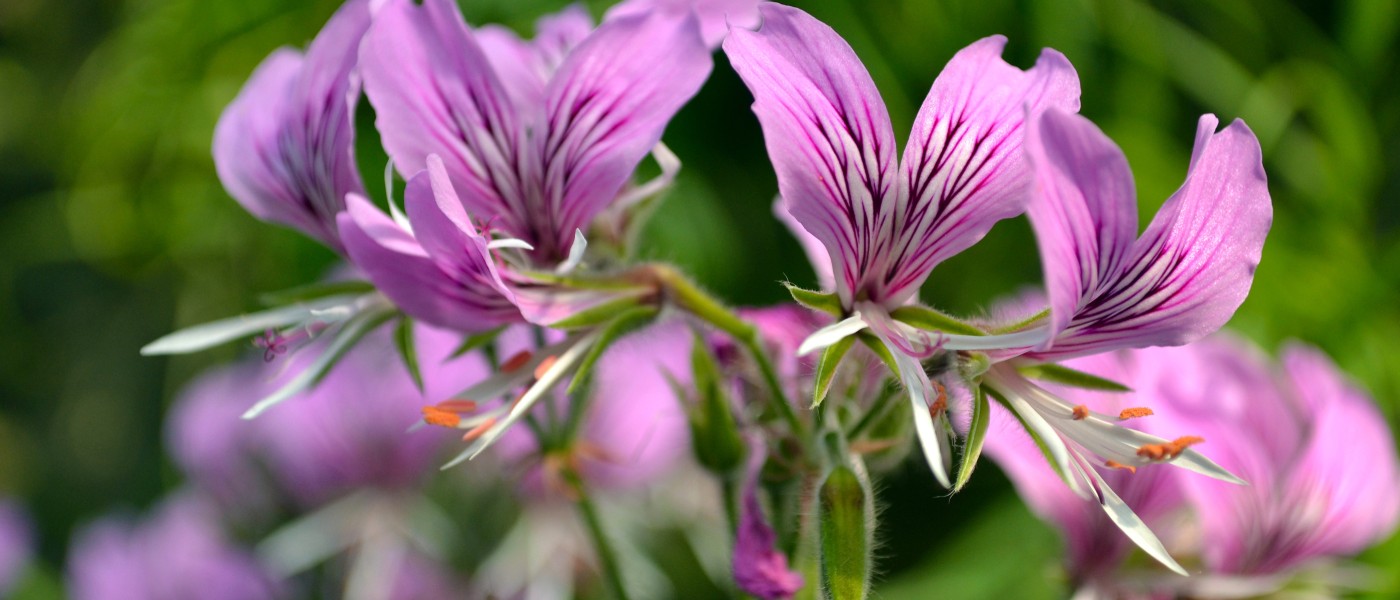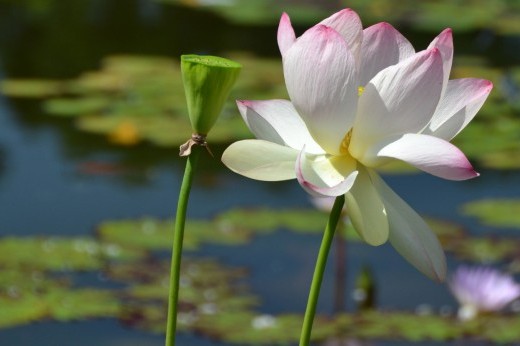In late winter, when much of the Garden lies dormant, the Warm Temperate Pavilion comes to life in a cascade of scents and colors. As you enter, you may spot a purplish flower whose petals and leaves resemble a heart. That’s Pelargonium cordifolium, or heart-leaved pelargonium, a flowering shrub from the Cape Floristic Region of South Africa.
Pelargonium cordifolium grows to around three feet tall and can be a bit scraggly in shape. In the wild, you might find these blooms poking out through a tangle of companion plants rather than standing alone. For a fuller display, gardeners tend to plant them in groups.
Its purple (or occasionally white) flowers have five petals; the top two petals are larger and marked with dark purple veins, while the three lower petals are smaller and lighter in color. Its heart-shaped leaves are hairy and smell slightly of apple.

Pelargonium hybrids, often known as geraniums, are beloved by gardeners around the world, but their place of origin is rarely highlighted in retail spaces or gardening articles. More than 80 percent of species in the genus hail from southern Africa, with the majority of these found in South Africa.
Geranium or pelargonium?
Most gardeners refer to pelargonium species as “geraniums.” This can get confusing, and is technically incorrect, since Geranium and Pelargonium are two different genera, or groups, belonging to the same family, Geraniaceae.
.jpg)
Common names for Geranium species are “cranesbill” or “hardy geranium”; common names for Pelargonium species are “geranium,” “pelargonium,” or “storksbill.”
The two genera are differentiated most easily by the shape of their flowers: Pelargonium flowers are bilaterally symmetrical, while geranium flowers are radially symmetrical. (The wonders of modern horticulture have confused things a bit further by producing pelargonium hybrids with symmetrical round inflorescences.)
The name for pelargonium is derived from the Greek pelargos, which means stork, referring to the pointy elongated attachment (rostrum) to the seed capsule (schizocarp), which is said to resemble a stork’s bill.
A fire-loving flower
Pelargonium cordifolium grows in the eastern half of the Fynbos Biome, a colorful shrubland ecosystem that covers most of the Cape Floristic Region (CFR) at the southwestern tip of South Africa. The CFR is considered a biodiversity hotspot, which means it is one of the planet’s most biologically diverse and threatened areas.

Fynbos (pronounced fane – boss) vegetation is dominated by evergreen shrubs and restios (grasslike plants from the Restionaceae family), and hosts a diverse array of geophytes, or plants with underground organs, like bulbs and tubers. Two-thirds of the more than 9,000 species found here, including P. cordifolium, are endemic, meaning they are found nowhere else. Major threats to the CFR include habitat loss from development and agriculture, habitat degradation, and invasive species.
Similar to chaparral ecosystems in the western United States, fynbos vegetation requires a regular fire cycle to rejuvenate. I recently saw big patches of Pelargonium cordifolium on rocky slopes while hiking in an area that had burned two years earlier. Like many pelargoniums, P. cordifolium is a pioneer species, which means it grows rapidly after fire and then becomes less prominent as slower-growing species start to compete for space.


A horticultural staple
Cape pelargoniums were introduced early to Western horticulture and proved to be extremely popular, and, ultimately, lucrative.
The Cape was an important refueling stop on European trade routes beginning in the late 15th century, with subsequent trading and conflict with the local Khoikhoi people by various fleets until the Dutch United East India Company established a permanent colony in 1652. This era of violent colonization and “discovery” saw the transport of many plants, as settlers grew European-style gardens and native plants considered potentially economically useful were introduced to Europe.

Pelargonium triste was likely the first of the genus to be introduced to Europe, sometime around the year 1600. Other species followed, and Pelargonium cordifolium was introduced to London’s Royal Botanic Gardens Kew by Francis Masson—a Scottish botanist and “plant hunter” who introduced over 1,000 species of plants to Britain—in 1774 after one of his three collecting trips to South Africa.
Today, window boxes in Europe and gardens around the world are filled with Pelargonium hybrids in various colors and shapes. Many forms of Pelargonium cordifolium are available today, prominent varieties being Pelargonium cordifolium var. rubrocinctum, Pelargonium cordifolium ‘Caroline’s Citrine’, and Pelargonium cordifolium ‘Donn’s Goldstrike’.

The genus is among hundreds of plants from the Cape Region that were eventually brought to the global market; others include bird-of-paradise (Strelitzia reginae), Gladiolus spp., and belladonna lily (Amaryllis belladonna).
Citizen science
Here in South Africa, we have an extremely active citizen science community, with thousands of users on the iNaturalist app. Pelargoniums also have a strong international following, with several societies and websites devoted to growing and appreciating them. On iNaturalist, in what’s become a generative and inclusive approach to the production of botanical knowledge, local and international pelargonium fans come together to confirm sightings and swap expertise.
The bonds between South African and international plant people continue to foster interesting collaborations, like an upcoming field guide on pelargoniums by Cape-based conservationist Riaan van der Walt and Matija Strlic, a chemist and curator of the Reference Collection of Pelargoniums of the International Geraniaceae Group.
Next time you visit the Warm Temperate Pavilion at Brooklyn Botanic Garden, see if you can catch a faint whiff of the apple-like scent of P. cordifolium, and take a moment to consider the origins and unique habitat of this remarkable plant.
Further reading
Pelargoniums of Southern Africa, by J.J.A. van der Walt
The Old Company’s Garden at the Cape and Its Superintendents, by Mia C. Karsten
Guide to Plant Families in Southern Africa, by M. Koekemoer, HM Steyn and SP Bester
Pelargonium: By Any Other Name Would Smell As Sweet? The Plant Humanities Lab
The Pelargonium Page, by Matija Strlic
Plants of the Greater Cape Floristic Region 1: The Core Cape Flora, by John Manning & Peter Goldblatt
Pelargonium Cordifolium, South African National Biodiversity Institute (SANBI)



